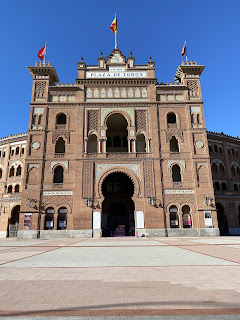I don’t have a lot to share today. I went two places and had two meals. Both sets were completely different. As part of my Sabbatical, I wanted to learn about food insecurity issues in other “First World Countries”. I wanted to ask some of the following questions: how much food insecurity is there, how is it addressed/managed, what are the interconnecting issues, how do these issues compare to back home, and what ways are others addressing this issue better and what ways could we share with others to help them.
My first visit this morning was to the Madrid Food Bank. This is very similar to the Greater Pittsburgh Community Food Bank. As a local “satellite” location in West Elizabeth, our processes are very different. But I know a fair amount about the Greater Pittsburgh Food Bank to make some knowledgable comparisons and to understand. I also got to help load some of the morning trucks that came in to pick up food for their satellite locations. One of the big differences between Madrid (covers over 3M people) and GPCFB (which covers 2.3M people) is that Madrid’s operates almost solely on volunteer support - about 400 volunteers. The only paid staff (25 Total) are shift directors and Administrators. GPCFB employees about 120 staff with over 6,000 volunteers. Madrid Food Bank is located in a large church and surrounding buildings that had been a school which were given to them.
Here are some pictures:
Esteban, one of the building’s sub-directors, is a volunteer and has been helping for the last 3 years. He picked me up and showed me around.
Prior to visiting the Madrid Food Bank, I stopped for breakfast at the Metro Station where I was meeting Esteban. I had the best piece of Carrot Cake I’ve ever eaten. The coffee, however, was too sweet. It was called a Cafe Bombon. It contained sweetened condensed milk. Oh well, so much for not knowing enough Spanish and therefore guessing and hoping for the best.
By the afternoon, I’d gotten as much out of the experience as I could and Esteban took me back to the area he’d found me. From here I went to the Plaza de Torres Monumental de Las Ventas- the Bull Ring.
Everyone has strong emotions about the bull ring. Most Spaniards no longer like it and are against its practice. Here are some of my pictures:
The plaque stays: “The story of bullfighting is linked to Spain’s history in such a way that without knowing the first, it would be impossible to understand the second.” Whether you like bullfighting or not, bullfighting is definitely a part of Spain’s past and like the plague says, I’ve always believed that it is important to know and understand our pasts in order for us to navigate the future.































No comments:
Post a Comment